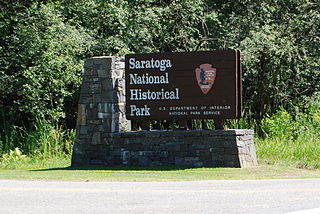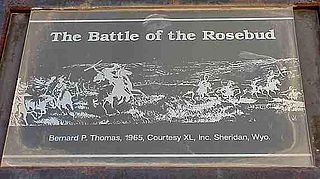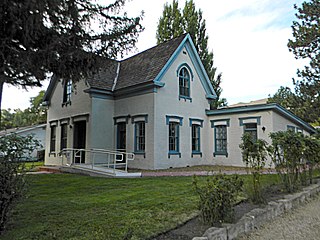
Fort D. A. Russell, also known as Fort Francis E. Warren, Francis E. Warren Air Force Base and Fort David A. Russell, was a post and base of operations for the United States Army, and later the Air Force, located in Cheyenne, Wyoming. The fort had been established in 1867 to protect workers for the Union Pacific Railroad. It was named in honor of David Allen Russell, a Civil War general killed at the Battle of Opequon. In 1930, the fort's name was changed to Fort Francis E. Warren. In 1949, it became Francis E. Warren Air Force Base.

Bent's Old Fort is an 1833 fort located in Otero County in southeastern Colorado, United States. A company owned by Charles Bent and William Bent and Ceran St. Vrain built the fort to trade with Southern Cheyenne and Arapaho Plains Indians and trappers for buffalo robes. For much of its 16-year history, the fort was the only major white American permanent settlement on the Santa Fe Trail between Missouri and the Mexican settlements. It was destroyed under mysterious circumstances in 1849.

Saratoga National Historical Park is a United States National Historical Park located in the Town of Stillwater in eastern New York, forty miles (64 km) north of Albany. The park preserves the site of the Battles of Saratoga.

Fort Fetterman was a wooden fort constructed in 1867 by the United States Army on the Great Plains frontier in Dakota Territory, approximately 11 miles northwest of present-day Douglas, Wyoming. Located high on the bluffs south of the North Platte River, it served as a major base for the start of several United States military expeditions against warring Native American tribes. The main role of the soldiers was to protect European-American pioneers on the Bozeman Trail. The fort is listed on the National Register of Historic Places.

The Cheyenne Depot Museum is a railroad museum located in Cheyenne, Wyoming.

The Clinton House is an 18th-century Georgian stone building in the city of Poughkeepsie, Dutchess County, New York, United States. It is a New York State Historic Site and has been listed in the National Register of Historic Places as a historic place of local significance since 1982. The house was named for George Clinton, who served as the first Governor of New York and fourth Vice-President of the United States. He was believed to have lived there after the American Revolutionary War, but it is now known that it was never his residence.
The Wyoming Governor's Mansion is the official residence of the Governor of Wyoming. The current mansion was built during 1976 in Cheyenne.

The F.F. Tomek House, also known as The Ship House or as the Ferdinand Frederick and Emily Tomek House, is a historic house at 150 Nuttall Road in Riverside, Illinois. It is prominent example of Prairie School design by Frank Lloyd Wright. Designed in 1904 and construction finished in 1906, the Tomek House is a well-preserved example of the style. In addition to being a good example of the Prairie style, the Tomek house documents the development of the style, which reached its clearest expression in Wright's Robie House in 1908. It is included in the Riverside Historic District and was declared a National Historic Landmark in 1999.

Rosebud Battlefield State Park in Big Horn County, Montana preserves a large portion of the battlefield of the Battle of the Rosebud, fought on June 17, 1876. The battle is known by various other names including The Battle Where the Girl Saved Her Brother by the Northern Cheyenne, and Crook's Fight on the Rosebud. A National Historic Landmark, the park is a day use facility offering hiking, hunting, picnicking and wildlife viewing. It is located 11 miles (18 km) south of Kirby, Montana on Montana Highway 314.

The Fort Laramie Three-Mile Hog Ranch was built to serve as a social center away from the soldiers' post at historic Fort Laramie. Fort Laramie was a 19th-century military post in eastern Wyoming. It became notorious as a place for gambling and drinking, and for prostitution, with at least ten prostitutes always in residence. The location is notable as an example of one of only a few military bordellos still standing in the United States by 1974, the time of its nomination to the National Register of Historic Places The Fort Laramie site was one of a number of so-called "hog ranches" that appeared along trails in Wyoming.

The Dull Knife Battlefield is located on the eastern slope of the Bighorn Mountains in Johnson County, Wyoming near Kaycee. It was the scene of the Dull Knife Fight on November 25, 1876, in which the Fourth Cavalry under General Ranald S. Mackenzie raided the winter encampment of the NorthernCheyenne, destroying most of their material culture and all their winter supplies and thus forcing the Northern Cheyenne to seek shelter with the village of Crazy Horse in order to survive the winter. Five hundred ponies were captured and about 173 lodges destroyed. The Dull Knife battlefield is on private land and is available to visit only by special arrangement. The fight took place on November 25, 1876.

The Ferdinand Ewert Building was an historic row house located in the West End of Davenport, Iowa, United States. It was a Vernacular style building that featured elements of both the Federal and Greek Revival styles. This combination was one of the architectural trends toward the end of Davenport's settlement period. It followed a simple form with frontal symmetry and parapet gable ends. This house was probably built by Gottlieb Wedige right after this section of the city was platted in 1852. Ferdinand Ewert, a teamster who lived across the street, bought it in 1871. The building was listed on the National Register of Historic Places in 1983, and has subsequently been torn down.
William R. Dubois (1879-1953) was an American architect. He was a prolific architect in Wyoming and nearby states.

The Ormsby–Rosser House, at 304 S. Minnesota St. in Carson City, Nevada, is a historic house that was built during 1862-63. It was home of the widow of Major William B. Ormsby, who was killed in 1860 in the Pyramid Lake War. The house hosted Mark Twain and others. It was later owned by carpenter/cabinet-maker Sture Svensson, who added an addition in 1960.

The Castle on 19th Street or 19th Street Castle is a Mission Revival style house in Cheyenne, Wyoming. It was built in 1914 for local businessman Thomas Heaney, who operated the Atlas Theatre in Cheyenne. Heaney also operated the Tivoli Bar and Restaurant and became a Wyoming state senator representing Laramie County. Heaney's residence features a three-story corner tower with a broad overhanging tiled and hipped roof, with a stucco parapet surrounding the remainder of the roof, ornamented with projecting crests. A loggia with three arches fronts the house, ornamented with projecting squared beams. The driveway goes through the leftmost arch, flanked by a retaining wall, on its way to the rear of the house. The interior was converted for apartments.

The Crook House in Cheyenne, Wyoming, also known as Gibbons House, is a Queen Anne-style house that was built in 1890. It was listed on the National Register of Historic Places in 1979.

The Cheyenne High School at 2810 House Avenue in Cheyenne, Wyoming is a Late Gothic Revival-style building which was built in 1921. It has also been known as Central High School and as Laramie County School District No.1 Administration Building and was listed on the National Register of Historic Places in 2005.

The Durlacher House, or Durlacher Residence is a Queen Anne style house in Laramie, Wyoming. It was built between 1875 and1878 by Charles Klingerman. In 1878 it was purchased by German immigrants Simon and Hannah Durlacher.

Keefe Row, at E. 22nd St. and Evans Ave. in Cheyenne, Wyoming, was built in 1892. It was listed on the National Register of Historic Places in 1979.

The Whipple-Lacey House, at 300 E. 17th St. in Cheyenne, Wyoming, was built in 1883. It was listed on the National Register of Historic Places in 1980.






















